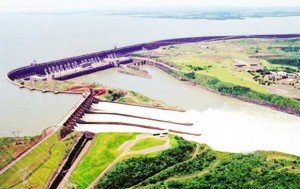Latest update November 22nd, 2024 1:00 AM
Latest News
- Exxon wants new oil block on own terms
- Indian companies eye Guyana’s oil
- ICC issues arrest warrant for Israeli PM Netanyahu for ‘war crimes’ in Gaza
- Developing countries should not be curtailed in exploiting natural resources- PM Modi tells Parliament
- Govt- owned Marriott sells VP Jagdeo expired soft drink
Report warns of negative impacts of hydro dams in Amazon basin…Bankers, contractors will hog benefits
May 07, 2014 News
A new report has indicated that a staggering 400-plus hydro-power dams will be built in the Amazon basin, including two planned for Guyana. It would potentially lead to the “end of free-flowing rivers” and contribute to “ecosystem collapse”, causing huge social problems.
The report also warned that the majority of the benefits derived from the construction of mega- projects directly go to actors, including multi-national corporations and the financing institutions.

The construction of hydro-electric dams in the Amazon Basin will have negative
effects on the area, a Brazilian university anthropologist has warned.
Of the 412 dams already in operation, under construction or proposed, 256 are in Brazil, 77 in Peru, 55 in Ecuador, 14 in Bolivia, six in Venezuela, two planned in Guyana, and one each in Colombia, French Guiana and Suriname.
Brazilian Anthropologist, Paul Little, at the launch of the English version of his report, “Mega-Development Projects in Amazonia: A Geo-Political and Socio-Environmental Primer”, said that 151 of the 412 dams involve five of the six main rivers that drain into the Amazon after birthing in the Andes. The report was launched by the Brazilian in Lima, Peru, late last month. Little is attached to the Department of Anthropology, University of Brasilia, Brazil.
“The construction of many large-scale dams in the vast headwaters region of the Amazon Basin – encompassing parts of Bolivia, Peru, Ecuador and Colombia – will produce critical changes in continental water flows, with little knowledge of the ecological consequences of this policy,” the report states.
“This new wave of dam building in the headwaters of the Basin is a “hydrological experiment” of continental proportions, yet little is known scientifically of pan-Amazonian hydrological dynamics, creating the risk of provoking irreversible changes in rivers.”
The report, co-authored and circulated by Peruvian NGO DAR, divides “mega-development projects” into two kinds – infrastructure, such as the transport and electricity sectors, which in turn includes hydroelectric dams; and extractive, such as oil, gas and mining.
According to a report yesterday in www.guardian.com, the focus is on the number of current projects, the larger global financial, regional and geopolitical contexts, and the potential social and environmental impacts.
“The weight of these socio-environmental impacts is distributed in an extremely unequal manner. The majority of the benefits derived from the construction of mega-development projects accrue to economic and political actors external to Amazonia, such as large multi-national corporations, the administrative apparatus of national governments and financial institutions.”
The report also warned that the majority of negative impacts of these same mega-development projects are borne by indigenous peoples, who suffer from the invasion of their territories, and local communities, which suffer from the proliferation of serious social and health problems.
A section of the report makes recommendation to what can be done to counter such projects and the impacts they may have, and includes proposals for a “pan-Amazonian agenda for an alternative model of development.”
According to Little, 1.6 million square kilometres of the Amazon is covered by mining concessions with 1.1M set for oil and gas concessions.
The Amazon rainforest spans 5.5M square kilometres (2.1M square miles) and includes territories belonging to nine nations.
The majority of the forest is contained within Brazil, with 60% of the rainforest, followed by Peru with 13%, Colombia with 10%, and with minor amounts in Venezuela, Ecuador, Bolivia, Guyana, Suriname and French Guiana.
Guyana is currently pursuing building a 165-megawatts facility at Amaila Falls, Region Eight. The project ran into problems last year after the National Assembly remained divided on how the US$850M-plus would be spent. It would be the largest ever infrastructural project for Guyana, if financing is found and given the requisite approval.
Talks are still ongoing with the financiers, Chinese contractor, and US developer on that project.
Talks are also continuing with neighbouring Brazil to build a hydro-electric dam in the Lower Mazaruni, Region Seven. Brazil would be taking a significant portion of the power with the rest being introduced to the Guyana system.
Guyana has been desperately seeking alternative power with its import oil bill continuing to account for a huge chunk of its foreign spending.
Share this:
- Click to print (Opens in new window)
- Click to email a link to a friend (Opens in new window)
- Click to share on Facebook (Opens in new window)
- Click to share on WhatsApp (Opens in new window)
- Click to share on Twitter (Opens in new window)
- Click to share on Pinterest (Opens in new window)
- Click to share on Pocket (Opens in new window)
- Click to share on Tumblr (Opens in new window)
- Click to share on Reddit (Opens in new window)
- Click to share on LinkedIn (Opens in new window)
Related
Similar Articles

The Glenn Lall Show | November, 20th, 2024
Follow on Tik Tok @Glennlall
THE BLUNT OF THE DAY

Sports
Nov 22, 2024
-Guyana to face Canada today By Rawle Toney The Green Machine, Guyana’s national rugby team, is set to make its mark at this year’s Rugby Americas North (RAN) Sevens Championship, hosted at...Features/Columnists
A false panacea for electoral integrity
…Peeping Tom kaieteur News – Advocates for fingerprint verification in Guyana’s elections herald it as... more
Rising Gun Crimes in the Caribbean: Urgent Action required by all
By Sir Ronald Sanders Kaieteur News – There is an alarming surge in gun-related violence, particularly among younger... more
Publisher’s Note
Freedom of speech is our core value at Kaieteur News. If the letter/e-mail you sent was not published, and you believe that its contents were not libellous, let us know, please contact us by phone or email.
Feel free to send us your comments and/or criticisms.
Contact: 624-6456; 225-8452; 225-8458; 225-8463; 225-8465; 225-8473 or 225-8491.
Or by Email: [email protected] / [email protected]
Weekend Cartoon














